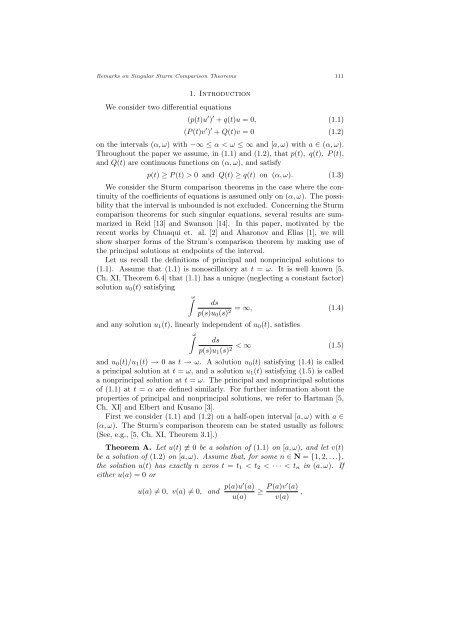REMARKS ON SINGULAR STURM COMPARISON THEOREMS
REMARKS ON SINGULAR STURM COMPARISON THEOREMS
REMARKS ON SINGULAR STURM COMPARISON THEOREMS
You also want an ePaper? Increase the reach of your titles
YUMPU automatically turns print PDFs into web optimized ePapers that Google loves.
Remarks on Singular Sturm Comparison Theorems 111<br />
1. Introduction<br />
We consider two differential equations<br />
(p(t)u ′ ) ′ + q(t)u = 0, (1.1)<br />
(P (t)v ′ ) ′ + Q(t)v = 0 (1.2)<br />
on the intervals (α, ω) with −∞ ≤ α < ω ≤ ∞ and [a, ω) with a ∈ (α, ω).<br />
Throughout the paper we assume, in (1.1) and (1.2), that p(t), q(t), P (t),<br />
and Q(t) are continuous functions on (α, ω), and satisfy<br />
p(t) ≥ P (t) > 0 and Q(t) ≥ q(t) on (α, ω). (1.3)<br />
We consider the Sturm comparison theorems in the case where the continuity<br />
of the coefficients of equations is assumed only on (α, ω). The possibility<br />
that the interval is unbounded is not excluded. Concerning the Sturm<br />
comparison theorems for such singular equations, several results are summarized<br />
in Reid [13] and Swanson [14]. In this paper, motivated by the<br />
recent works by Chuaqui et. al. [2] and Aharonov and Elias [1], we will<br />
show sharper forms of the Strum’s comparison theorem by making use of<br />
the principal solutions at endpoints of the interval.<br />
Let us recall the definitions of principal and nonprincipal solutions to<br />
(1.1). Assume that (1.1) is nonoscillatory at t = ω. It is well known [5,<br />
Ch. XI, Theorem 6.4] that (1.1) has a unique (neglecting a constant factor)<br />
solution u 0 (t) satisfying<br />
∫ ω<br />
ds<br />
= ∞, (1.4)<br />
p(s)u 0 (s)<br />
2<br />
and any solution u 1 (t), linearly independent of u 0 (t), satisfies<br />
∫ ω<br />
ds<br />
p(s)u 1 (s) 2 < ∞ (1.5)<br />
and u 0 (t)/u 1 (t) → 0 as t → ω. A solution u 0 (t) satisfying (1.4) is called<br />
a principal solution at t = ω, and a solution u 1 (t) satisfying (1.5) is called<br />
a nonprincipal solution at t = ω. The principal and nonprincipal solutions<br />
of (1.1) at t = α are defined similarly. For further information about the<br />
properties of principal and nonprincipal solutions, we refer to Hartman [5,<br />
Ch. XI] and Elbert and Kusano [3].<br />
First we consider (1.1) and (1.2) on a half-open interval [a, ω) with a ∈<br />
(α, ω). The Sturm’s comparison theorem can be stated usually as follows:<br />
(See, e.g., [5, Ch. XI, Theorem 3.1].)<br />
Theorem A. Let u(t) ≢ 0 be a solution of (1.1) on [a, ω), and let v(t)<br />
be a solution of (1.2) on [a, ω). Assume that, for some n ∈ N = {1, 2, . . .},<br />
the solution u(t) has exactly n zeros t = t 1 < t 2 < · · · < t n in (a, ω). If<br />
either u(a) = 0 or<br />
u(a) ≠ 0, v(a) ≠ 0, and p(a)u′ (a)<br />
u(a)<br />
≥ P (a)v′ (a)<br />
v(a)<br />
,

















